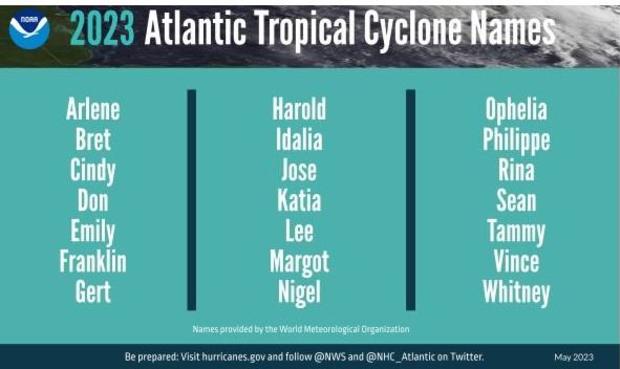NOAA forecasts near-normal Atlantic hurricane season: 'time to be prepared'
BALTIMORE -- Forecasters are telling residents to not take hurricane season lightly.
The official hurricane season is considered to go from June 1 through Nov. 30. However, that doesn't mean those powerful storms will fit in that timeline.
"Regardless of the number of named storms out there and regardless of the time, it just takes one, and it could happen with the very first one to cause significant damage," said FEMA Administrator Deanne Criswell. "So, we do need to prepare today."
The National Oceanic and Atmospheric Administration (NOAA) is predicting a near-normal 2023 Atlantic hurricane season with between 12 to 17 named storms.
NOAA forecasts up to four major hurricanes with wind gusts up to at least 111 mph, which categorize as at least a Category 3 storm. Up to nine hurricanes are forecast to have wind speeds of at least 74 mph.
"It's time to be prepared," said NOAA Administrator Dr. Rick Spinrad. "It only takes one storm to devastate a community. If one of those named storms is hitting your home and community, it's very serious."
Dr. Spinrad said there is a 40 percent chance we have a near-normal hurricane season, a 30 percent chance it is above normal and a 30 percent chance of being below normal.
Officials said previously used hurricane names - Fiona and Ian - have been retired.
NOAA released the names of the 21 tropical storm names.
NOAA forecasts the Atlantic hurricane season to be less active than in recent years because of several factors.
After three hurricane seasons with La Nina present, NOAA scientists predict a high potential for El Nino to develop this summer, which can suppress Atlantic hurricane activity, according to NOAA.
El Nino's potential influence on storm development could be offset by favorable conditions local to the tropical Atlantic Basin.
Those conditions include the potential for an above-normal west African monsoon, which produces African easterly waves and seeds some of the stronger and longer-lived Atlantic storms, and warmer-than-normal sea surface temperatures in the tropical Atlantic Ocean and Caribbean Sea which creates more energy to fuel storm development.
These factors are part of the longer-term variability in Atlantic atmospheric and oceanic conditions that are conducive to hurricane development — known as the high-activity era for Atlantic hurricanes — which have been producing more active Atlantic hurricane seasons since 1995.
"With a changing climate, the data and expertise NOAA provides to emergency managers and partners to support decision-making before, during and after a hurricane has never been more crucial," said Dr. Spinrad. "To that end, this year we are operationalizing a new hurricane forecast model and extending the tropical cyclone outlook graphic from five to seven days, which will provide emergency managers and communities with more time to prepare for storms."
This summer, NOAA said it will implement a series of upgrades and improvements.
NOAA will expand the capacity of its operational supercomputing system by 20 percent. This increase in computing capability will enable NOAA to improve and run more complex forecast models, including significant model upgrades this hurricane season:
- In late June, the Hurricane Analysis and Forecast System (HAFS) will become operational. HAFS will run this season in tandem with the currently operational Hurricane Weather Research and Forecast Model System and Hurricanes in a Multi-scale Ocean-coupled Non-hydrostatic model, but eventually will become NOAA's primary hurricane model. Retrospective analysis of tropical storms and hurricanes from the 2020-2022 seasons show that this model has a 10-15% improvement in track forecasts over existing operational models. This new model was jointly created by NOAA's Atlantic Oceanographic & Meteorological Laboratory Hurricane Modeling and Prediction Program and NOAA's National Weather Service Environmental Modeling Center.
- The Probabilistic Storm Surge model upgrade on May 2, advances storm surge forecasting for the contiguous U.S. and new forecasts for surge, tide and waves for Puerto Rico and the U.S. Virgin Islands. Forecasters now have the ability to run the model for two storms simultaneously. This model provides forecasters with the likelihood, or probability, of various flooding scenarios including a near worst-case scenario to help communities prepare for all potential outcomes.
Additional upgrades or new tools for hurricane analysis and forecasting include:
- The National Hurricane Center's Tropical Weather Outlook graphic, which shows tropical cyclone formation potential, has expanded the forecast range from five to seven days.
- Over the last 10 years, flooding from tropical storm rainfall was the single deadliest hazard. To give communities more time to prepare, the Weather Prediction Center is extending the Excessive Rainfall Outlook an additional two days, now providing forecasts up to five days in advance. The outlook shows general areas at risk for flash flooding due to excessive rainfall.
- The National Weather Service will unveil a new generation of forecast flood inundation mapping for portions of Texas and portions of the Mid-Atlantic and Northeast in September 2023. These forecast maps will extend to the rest of the U.S. by 2026. Forecast flood inundation maps will show the extent of flooding at the street level.
NOAA will continue improving new and current observing systems critical in understanding and forecasting hurricanes. Two projects underway this season include:
- New small aircraft drone systems, the deployment of additional Saildrones and underwater gliders, and WindBorne global sounding balloons. These new technologies will advance our knowledge of hurricanes, fill critical data gaps and improve hurricane forecast accuracy.
- The modernization and upgrade of the Tropical Atmosphere Ocean buoy array. The upgrade will provide additional capabilities, updated instruments, more strategic placement of buoys and higher-frequency observations. Data from these buoys are used to forecast El Nino and La Nina, which can influence hurricane activity.
In 2022, there were 14 storms in the Atlantic, including eight hurricanes. Two of those hurricanes were considered to be "major."
Hurricane Fiona had high winds of 140 mph and Ian, with 160 mph winds, hit Florida as a Category 4.
Hurricane season starts next week and officials are pre




